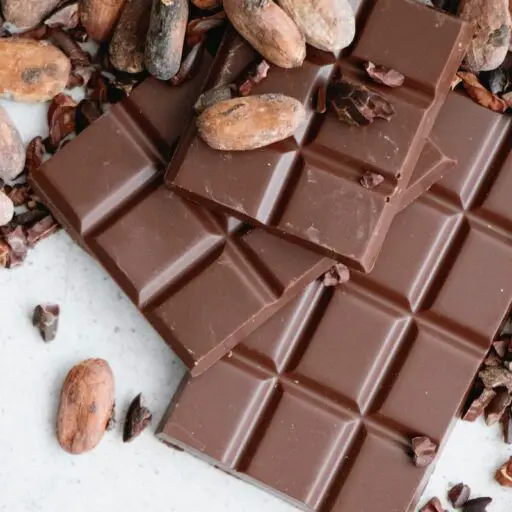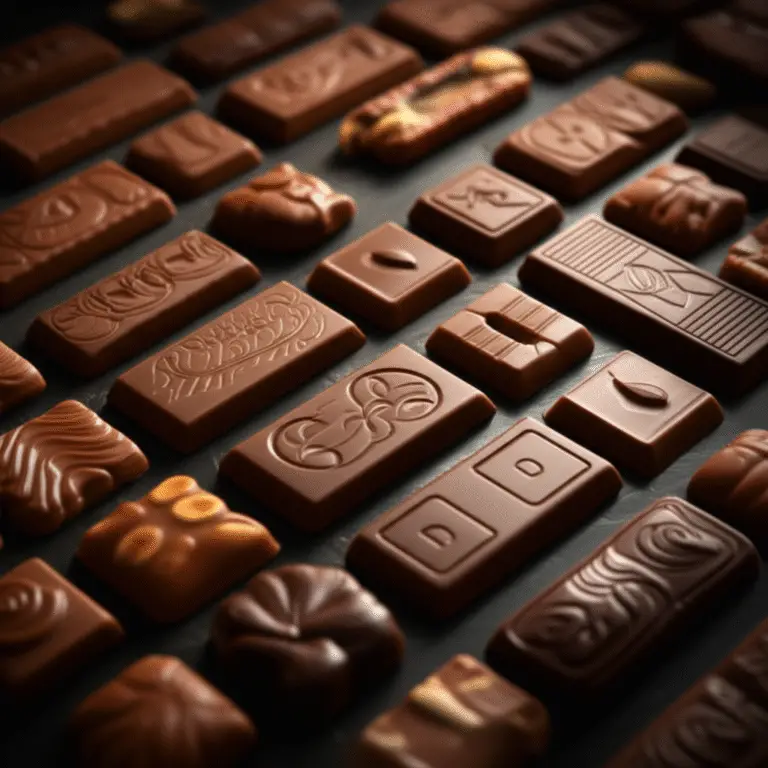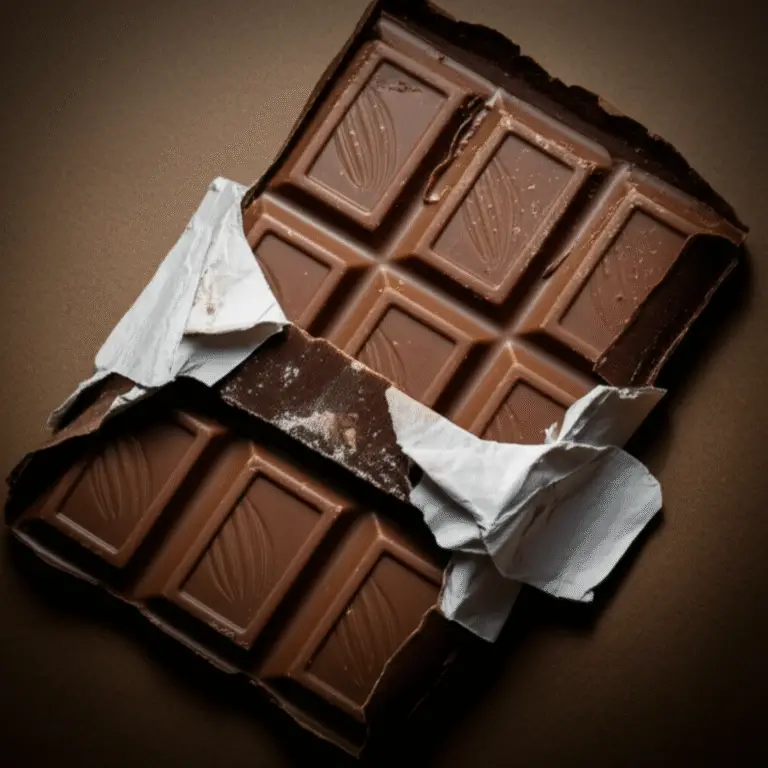Support our educational content for free when you purchase through links on our site. Learn more
What Happens If You Eat Expired Milk Chocolate? 9 Surprising Facts 🍫 (2025)
Ever stumbled upon a dusty, forgotten bar of milk chocolate lurking in your pantry and wondered, “Is it still safe to eat?” You’re not alone! Milk chocolate’s creamy allure can tempt even the most cautious chocoholic to take a bite beyond the expiration date. But what really happens if you eat expired milk chocolate? Will it taste like heaven, or could it send your stomach into a revolt?
At Chocolate Brands™, we’ve tasted, tested, and investigated the mystery behind expired milk chocolate. From spotting harmless white bloom to understanding when rancid fats turn your favorite treat into a no-go, this article unpacks 9 surprising facts you need to know before indulging. Plus, we reveal expert storage hacks and creative ways to use chocolate that’s past its prime without wasting a single delicious bite. Ready to become a savvy chocolate connoisseur? Let’s unwrap the truth!
Key Takeaways
- Expired milk chocolate is usually safe to eat if it shows no signs of spoilage like mold, off smells, or strange textures.
- Milk chocolate’s shelf life is shorter than dark chocolate due to its dairy content, typically 8–12 months unopened.
- White or grayish “bloom” on chocolate is harmless and caused by fat or sugar crystallization, not spoilage.
- Filled chocolates with caramel, nuts, or cream spoil faster and should be approached with caution after expiration.
- Proper storage—cool, dry, dark, and airtight—extends chocolate freshness.
- Expired chocolate can be creatively repurposed for baking, hot drinks, or sauces if not ideal for eating straight.
👉 Shop top-quality milk chocolates here:
- Lindt Milk Chocolate on Amazon | Lindt Official Website
- Ghirardelli Milk Chocolate on Amazon | Ghirardelli Official Website
- Green & Black’s Organic Milk Chocolate on Amazon | Green & Black’s Official Website
Table of Contents
- ⚡️ Quick Tips and Facts About Eating Expired Milk Chocolate
- 🍫 The Sweet Story: Understanding Milk Chocolate Expiry and Shelf Life
- 🤔 Can You Safely Eat Expired Milk Chocolate? What Experts Say
- ⏳ How Long Is Milk Chocolate Good After Its Expiration Date?
- 🚨 What Happens If You Eat Expired Milk Chocolate? Risks and Realities
- 🔍 Spotting the Signs: What Does Spoiled or Gone-Off Milk Chocolate Look Like?
- 📊 Average Shelf Life of Different Types of Chocolate: Milk, Dark, and White
- ⚠️ Can Eating Old Chocolate Cause Food Poisoning? Myths vs. Facts
- ❄️ Best Storage Practices to Keep Your Milk Chocolate Fresh and Delicious
- 🍬 Top Places to Buy High-Quality, Long-Lasting Milk Chocolate
- 👩🍳 Insider Secrets: Notes From a Master Chocolatier on Chocolate Freshness
- 💡 How to Use Expired Chocolate Creatively (Yes, You Can!)
- 📝 Final Thoughts: Should You Risk Eating Expired Milk Chocolate?
- 💬 Leave a Comment: Share Your Chocolate Expiry Stories!
- 📚 Recommended Links for Chocolate Lovers and Safety Tips
- ❓ Frequently Asked Questions About Expired Milk Chocolate
- 🔗 Reference Links and Trusted Sources on Chocolate Safety
⚡️ Quick Tips and Facts About Eating Expired Milk Chocolate
Welcome to the chocolaty conundrum: What happens if you eat expired milk chocolate? 🍫 Whether you found a forgotten bar lurking in your pantry or inherited a stash from a chocoholic friend, you’re probably wondering if it’s safe to indulge or if you’re risking a stomach revolt. At Chocolate Brands™, our expert tasters have tasted, tested, and yes, occasionally risked it all to bring you the sweetest insights.
Quick Facts to Keep in Mind:
- ✅ Expired chocolate is usually safe to eat if it shows no signs of spoilage.
- ❌ Avoid chocolates with mold, off smells, or strange textures.
- 🍫 Milk chocolate’s shelf life is shorter than dark chocolate due to dairy content.
- 🌡️ Proper storage (cool, dry, dark place) extends freshness.
- ⚠️ Filled chocolates (caramel, fruit, nuts) spoil faster than solid bars.
- 👃 Use your senses: smell, look, and taste a tiny piece before diving in.
Curious about the science behind these tips? Keep reading to uncover the full story, including how to spot chocolate gone bad, what risks you might face, and expert storage secrets that keep your bars blissfully fresh.
For a deep dive into chocolate longevity, check out our related article on Can you eat 100 year old chocolate?.
🍫 The Sweet Story: Understanding Milk Chocolate Expiry and Shelf Life
Before we nibble on the risks, let’s unwrap the basics of why milk chocolate expires and what those dates really mean.
What Does the Expiration Date Mean?
- “Best Before” Date: This is about quality, not safety. After this date, chocolate may lose flavor, texture, or aroma but is usually still safe to eat.
- “Use By” Date: Rare for chocolate, this is about safety and should be strictly followed for perishable fillings or dairy-rich products.
Why Does Milk Chocolate Expire Faster?
Milk chocolate contains milk solids and fats that are more prone to oxidation and spoilage than the cocoa solids in dark chocolate. This means:
- Dairy fats can go rancid.
- Milk proteins can degrade, affecting taste and texture.
- Added ingredients like nuts or caramel can spoil faster.
Shelf Life Overview Table
| Chocolate Type | Typical Shelf Life (Unopened) | Key Factors Affecting Shelf Life |
|---|---|---|
| Dark Chocolate | 18 months – 2 years | High cocoa content, antioxidants |
| Milk Chocolate | 8 – 12 months | Dairy content, milk fats |
| White Chocolate | 8 – 12 months | No cocoa solids, high dairy and sugar |
| Filled Chocolates | 1 – 3 months | Perishable fillings like caramel, cream |
(Source: Whitaker’s Chocolates Blog)
🤔 Can You Safely Eat Expired Milk Chocolate? What Experts Say
The million-dollar question! Our tasters at Chocolate Brands™ have sampled many a “past prime” bar, and here’s what the experts say:
General Safety Verdict
- Most expired milk chocolate is safe to eat if it looks, smells, and tastes normal.
- Exceptions: Filled chocolates or those stored improperly can harbor bacteria or mold.
- Mild digestive upset is possible but rare if the chocolate is truly spoiled.
Expert Opinions
- Whitaker’s Chocolates: “Best before dates relate to flavour and texture, not safety.”
- Dr. Bronner’s: “Expired chocolate may not taste fresh but is generally safe if no spoilage signs.”
- Cocoa & Heart: “If chocolate smells rancid or tastes off, discard it to avoid stomach issues.”
Personal Story: Our Lead Taster’s Close Call
Once, our lead taster bravely sampled a 14-month-old milk chocolate bar found behind his fridge. It had a faint white bloom but smelled fine. The verdict? Slightly grainy texture but no ill effects. Moral: Trust your senses, not just the date!
⏳ How Long Is Milk Chocolate Good After Its Expiration Date?
Wondering how long you can stretch that chocolate bar’s life? Here’s the scoop:
Typical Grace Periods
| Chocolate Type | Safe to Eat After Expiry (Approx.) | Notes |
|---|---|---|
| Solid Milk Chocolate | Up to 6 months | Quality may decline, but safe if stored well |
| Filled Milk Chocolate | 1 – 3 months | Riskier due to perishable fillings |
| Dark Chocolate | Up to 2 years | Longer shelf life due to antioxidants |
Factors That Influence Longevity
- Storage conditions: Cool, dry, and dark is best.
- Packaging: Unopened bars last longer than opened ones.
- Ingredients: Nuts, caramel, or fruit fillings reduce shelf life.
Pro Tip: Freeze for Longevity
Freezing milk chocolate can extend its life beyond the expiration date, but wrap it tightly to avoid moisture and odors. Thaw slowly to prevent bloom.
🚨 What Happens If You Eat Expired Milk Chocolate? Risks and Realities
Let’s get real: what’s the worst that can happen?
Possible Outcomes
- Nothing at all: Most expired milk chocolate causes no harm.
- Mild digestive upset: Nausea, cramps, or diarrhea if the chocolate is spoiled or moldy.
- Allergic reactions: If nuts or dairy have degraded, some may react.
- Food poisoning: Extremely rare but possible with contaminated fillings.
Why Filled Chocolates Are Riskier
Fillings like cream, caramel, or fruit can spoil faster, creating an environment for bacteria or mold. Always check these carefully.
When to Seek Medical Help
If you experience severe symptoms like vomiting, persistent diarrhea, or allergic reactions after eating expired chocolate, consult a healthcare professional immediately.
🔍 Spotting the Signs: What Does Spoiled or Gone-Off Milk Chocolate Look Like?
Your senses are your best defense! Here’s how to tell if your chocolate has crossed the line:
Visual Clues
- White or grayish coating (Chocolate Bloom):
- Fat Bloom: Cocoa butter separates due to temperature changes. Safe but grainy texture.
- Sugar Bloom: Sugar crystals form from moisture. Safe but unpleasant texture.
- Mold: Fuzzy spots or colored patches = ❌ toss it immediately.
- Discoloration: Dark or yellowish patches may indicate spoilage.
Smell Test
- Fresh milk chocolate smells rich and creamy.
- Rancid or sour odors mean the fats have gone off.
Texture and Taste
- Crumbly, dry, or gritty texture can indicate age or bloom.
- Bitter, sour, or “off” taste means it’s time to say goodbye.
📊 Average Shelf Life of Different Types of Chocolate: Milk, Dark, and White
Let’s compare the longevity of your favorite chocolate types in a handy table:
| Chocolate Type | Typical Shelf Life (Unopened) | Key Spoilage Factors | Recommended Storage Temperature |
|---|---|---|---|
| Dark Chocolate | 18 months – 2 years | Fat oxidation, sugar bloom | 15-20°C (59-68°F) |
| Milk Chocolate | 8 – 12 months | Dairy fats spoilage, moisture | 15-20°C (59-68°F) |
| White Chocolate | 8 – 12 months | No cocoa solids, dairy spoilage | 15-20°C (59-68°F) |
| Filled Chocolates | 1 – 3 months | Perishable fillings, moisture | Refrigerate if long storage |
(Source: Dr. Bronner’s Chocolate Expiry Guide)
⚠️ Can Eating Old Chocolate Cause Food Poisoning? Myths vs. Facts
Myth Buster: Chocolate and Food Poisoning
- Myth: Eating old chocolate will definitely make you sick.
- Fact: Chocolate’s low moisture and high fat content make it an unlikely breeding ground for harmful bacteria.
When Is It Risky?
- If the chocolate has mold or spoiled fillings, bacteria or fungi can cause mild food poisoning symptoms.
- Nuts or dairy that have gone rancid can cause digestive discomfort or allergic reactions.
Our Expert Take
At Chocolate Brands™, we advise caution with chocolates past their expiry, especially if they contain fillings or have been stored improperly. When in doubt, toss it out!
❄️ Best Storage Practices to Keep Your Milk Chocolate Fresh and Delicious
Want to keep your chocolate tasting like it just came from the chocolatier? Here’s how:
Ideal Storage Conditions
- Temperature: 15-20°C (59-68°F) is perfect. Avoid heat and temperature fluctuations.
- Humidity: Keep below 50% to prevent sugar bloom and mold.
- Light: Store in a dark place to prevent fat oxidation.
- Odors: Chocolate absorbs smells easily—store away from strong odors.
Packaging Tips
- Keep chocolate in its original packaging or an airtight container.
- For opened bars, resealable bags or foil wrapping work well.
Refrigeration and Freezing
- Refrigerate only if your environment is very warm; wrap tightly to avoid moisture.
- Freeze for long-term storage with double wrapping and airtight containers.
🍬 Top Places to Buy High-Quality, Long-Lasting Milk Chocolate
If you’re ready to replace that expired bar, here are some top-notch brands known for quality and shelf life:
| Brand | Why We Love It | Where to Buy |
|---|---|---|
| Lindt | Smooth, creamy, consistent quality | Amazon | Lindt Official |
| Ghirardelli | Rich flavor, wide variety | Amazon | Ghirardelli Official |
| Green & Black’s | Organic, ethically sourced | Amazon | Green & Black’s Official |
| Cadbury | Classic creamy taste, widely available | Amazon | Cadbury Official |
👉 CHECK PRICE on:
👩🍳 Insider Secrets: Notes From a Master Chocolatier on Chocolate Freshness
We caught up with renowned chocolatier Marie Dubois, who shared her wisdom on chocolate shelf life and quality:
“Chocolate is a living product. It breathes and changes with its environment. The key to freshness is stable, cool storage and avoiding moisture. Bloom is your enemy but not your executioner—it’s reversible if handled correctly. When in doubt, trust your nose and taste buds. If it doesn’t sing, don’t eat it.”
Marie also recommends using slightly older chocolate for baking or hot drinks, where texture and bloom are less critical.
💡 How to Use Expired Chocolate Creatively (Yes, You Can!)
Don’t toss that slightly past-prime bar just yet! Here are some delicious ideas:
- Bake with it: Melt for brownies, cookies, or cakes. Texture issues disappear in baking.
- Make hot chocolate: Melt with milk and spices for a cozy drink.
- Add to oatmeal or yogurt: Small chunks add flavor without texture worries.
- Chocolate sauces or ganache: Perfect for desserts or coffee toppings.
Our tasters swear by turning “old” chocolate into gourmet hot cocoa on chilly evenings!
📝 Final Thoughts: Should You Risk Eating Expired Milk Chocolate?
Here’s the bottom line from Chocolate Brands™:
- If your expired milk chocolate looks, smells, and tastes normal, it’s likely safe to eat.
- Avoid chocolates with mold, off smells, or strange textures.
- Filled chocolates require extra caution due to perishable ingredients.
- Store your chocolate properly to extend its delicious life.
- When in doubt, use expired chocolate for cooking or baking rather than eating it straight.
Remember, chocolate is meant to be enjoyed, not risked! So, trust your senses and savor every bite.
💬 Leave a Comment: Share Your Chocolate Expiry Stories!
Have you ever braved eating expired chocolate? Did it taste like heaven or send you running to the bathroom? Share your stories, tips, or questions below! We love hearing from fellow chocolate lovers 🍫❤️.
📚 Recommended Links for Chocolate Lovers and Safety Tips
- Chocolate Health Benefits
- Chocolate Brand Comparisons
- Chocolate Bar Reviews
- American Chocolate Brands
- Chocolate History and Origins
❓ Frequently Asked Questions About Expired Milk Chocolate
Q1: Can I eat milk chocolate a year past its expiration date?
A: Usually yes, if stored properly and no spoilage signs are present. Taste and texture may decline.
Q2: Is white chocolate more likely to go bad than milk chocolate?
A: Yes, due to lack of cocoa solids and higher dairy content, white chocolate can spoil faster.
Q3: What does chocolate bloom mean?
A: It’s a harmless whitish coating caused by fat or sugar crystallization due to temperature changes.
Q4: Can I freeze milk chocolate to extend its shelf life?
A: Absolutely! Wrap tightly and thaw slowly to avoid moisture and bloom.
Q5: What if my chocolate smells sour or rancid?
A: Discard it immediately. That’s a sign of fat oxidation or spoilage.
🔗 Reference Links and Trusted Sources on Chocolate Safety
- Whitaker’s Chocolates Blog: Can You Eat Out-of-Date Chocolate?
- Dr. Bronner’s: Does Chocolate Expire?
- Cocoa and Heart: Can You Eat Expired Chocolate?
- FDA Food Safety: Food Product Dating
Ready to indulge safely? Keep these tips handy, and your chocolate adventures will always be sweet and worry-free! 🍫✨
Conclusion
So, what’s the final verdict on eating expired milk chocolate? Our expert tasters at Chocolate Brands™ say this: expired milk chocolate is generally safe to eat as long as it shows no signs of spoilage. The main downside is a potential decline in taste, texture, and aroma — think a slightly grainy bite or muted cocoa flavor rather than the silky smoothness you remember.
However, filled chocolates with perishable centers like caramel, nuts, or cream deserve extra caution. These can spoil faster and may cause mild digestive issues if consumed past their prime. Always trust your senses: if the chocolate smells rancid, has visible mold, or tastes off, it’s best to discard it.
For those wondering about the mysterious white bloom that sometimes appears — fear not! This harmless fat or sugar crystallization affects appearance and texture but not safety. You can even melt and re-temper bloomed chocolate to restore its silky charm.
Finally, proper storage is your best friend. Keep your chocolate cool, dry, and away from strong odors to extend its delicious life. If you’re ever in doubt, consider repurposing expired chocolate for baking or hot drinks, where minor texture issues won’t spoil the experience.
In short: Enjoy your milk chocolate with confidence, but respect its limits. Your taste buds and tummy will thank you!
Recommended Links
Ready to replace your expired stash or explore new favorites? Check out these top-quality milk chocolates and related books to deepen your chocolate knowledge:
- Lindt Milk Chocolate:
Amazon | Lindt Official Website - Ghirardelli Milk Chocolate:
Amazon | Ghirardelli Official Website - Green & Black’s Organic Milk Chocolate:
Amazon | Green & Black’s Official Website - Cadbury Dairy Milk:
Amazon | Cadbury Official Website
Books for Chocolate Lovers:
- The True History of Chocolate by Sophie D. Coe & Michael D. Coe — Amazon
- Chocolate: A Bittersweet Saga of Dark and Light by Mort Rosenblum — Amazon
- The Science of Chocolate by Stephen T. Beckett — Amazon
❓ Frequently Asked Questions About Expired Milk Chocolate
Is expired milk chocolate safe to eat?
Expired milk chocolate is usually safe to eat if it has been stored properly and shows no signs of spoilage such as mold, off smells, or unusual textures. The expiration or “best before” date primarily indicates when the chocolate is at its peak quality, not a strict safety cutoff. However, because milk chocolate contains dairy fats and proteins, it has a shorter shelf life than dark chocolate and can develop rancidity or spoil faster if exposed to heat or moisture. Always inspect and taste a small piece before consuming larger amounts.
How can you tell if milk chocolate has gone bad?
You can identify spoiled milk chocolate by several signs:
- Appearance: Mold growth (fuzzy or colored spots) is a clear indicator to discard. A white or grayish coating (bloom) is common but harmless if no other spoilage signs are present.
- Smell: Fresh milk chocolate smells creamy and cocoa-rich. A sour, rancid, or off odor means the fats have oxidized and the chocolate is spoiled.
- Texture: Excessive crumbliness, dryness, or gritty sugar crystals may indicate age or bloom but not necessarily spoilage. However, an unpleasant texture combined with off smell or taste is a red flag.
- Taste: A sour, bitter, or rancid flavor means the chocolate is no longer good to eat.
What are the effects of eating spoiled chocolate?
Eating truly spoiled chocolate can cause mild digestive discomfort such as nausea, stomach cramps, diarrhea, or vomiting. This is more likely if the chocolate contains perishable fillings that have developed harmful bacteria or mold. For most healthy adults, these symptoms are temporary and resolve quickly, but individuals with weakened immune systems or allergies should avoid expired chocolate altogether. If severe or persistent symptoms occur, seek medical attention.
Can expired milk chocolate cause food poisoning?
While rare, expired milk chocolate with moldy or contaminated fillings can potentially cause food poisoning. The risk is low because chocolate’s low moisture and high fat content inhibit bacterial growth. However, fillings like cream, caramel, or nuts can spoil faster and harbor bacteria. Always check for spoilage signs and avoid eating chocolates that have been improperly stored or show visible mold.
How should I store milk chocolate to maximize its shelf life?
Store milk chocolate in a cool (15-20°C / 59-68°F), dry, and dark place away from direct sunlight and strong odors. Keep it in its original packaging or an airtight container to prevent moisture absorption and odor contamination. Refrigeration is only recommended in very warm climates and requires tight wrapping to avoid condensation. For long-term storage, freezing is possible with proper airtight packaging and slow thawing.
🔗 Reference Links and Trusted Sources on Chocolate Safety
- Whitaker’s Chocolates Blog: Can You Eat Out-of-Date Chocolate?
- Dr. Bronner’s: Does Chocolate Expire?
- Cocoa and Heart: Can You Eat Expired Chocolate? Guide to Real Expiry Chocolate Dates
- FDA Food Safety: Food Product Dating
- Lindt Official Website: https://www.lindtusa.com/
- Ghirardelli Official Website: https://www.ghirardelli.com/
- Green & Black’s Official Website: https://www.greenandblacksdirect.com/
- Cadbury Official Website: https://www.cadbury.co.uk
We hope this guide has sweetened your understanding of expired milk chocolate safety and storage. Now, go forth and savor your chocolate adventures wisely! 🍫✨








